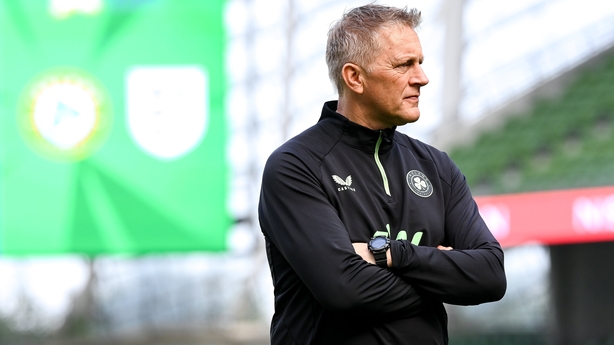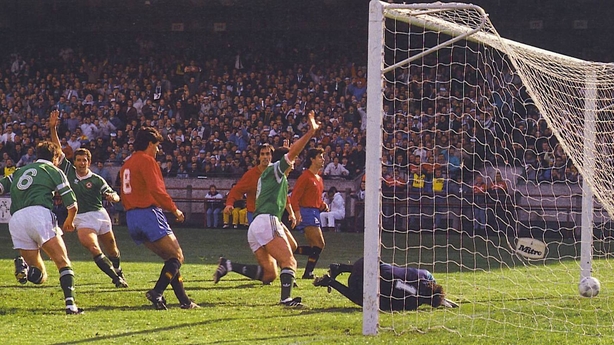Rose-tinted glasses. Everyone's got a pair lying around the house somewhere, but unlike your normal specs that come out to read or when the sun comes out, these ones tend to come out when the going gets tough and help you to remember "the good ole times".
These rose spectacles are selling by the bucketload at the minute, specifically amongst Irish soccer fans who are a bit aggrieved, shall we say, with the performances of the national team, despite the arrival of new manager Heimir Hallgrimsson.
The Icelandic coach was drafted in by the FAI back in July, after perhaps one of the most drawn-out selection processes ever witnessed.
A pair of 2-0 Nations League defeats at the hands of England and Greece at the Aviva have people up and down the country sweating, wondering if any manager is capable of bringing this team back to a World Cup, when it is hosted in North America in 2026.
In the time since the country qualified for Euro 2012 and 2016, we have witnessed a steady decline in ranking, club status of players, attendances and pretty much every other matrix.
Figures such as former boss Brian Kerr and podcaster Eamon Dunphy have been quick to cast doubt on the new manager’s approach thus far. Hallgrimsson does not travel to watch his players turn out for their clubs at the weekend, a strange choice when trying to uncover a few hidden gems across the water or check in on how one of your current squad is performing.
After a mixed tenure in charge of the Jamaican national team, which concluded with a modest 40% win ratio, the man from Iceland is yet to warm the cockles of even the most optimistic of supporters here.

However, before we get the daggers out and write off the squad’s chances of reaching the US, Canada and Mexico, perhaps we should take off those tinted glasses and look back at a time when things were not all sweetness and light. A time when Ireland came through a lesser-known period of struggle, amidst perhaps their most successful era under "Big Jack", to emerge as giants amongst men.
1988. The Irish squad arrived back in Dublin after competing in their first-ever major tournament, Euro ’88 which was held in West Germany.
It had been a triumph. Who could forget Ray Houghton’s early winner against the old enemy that was Bobby Robson’s England. The draw against a hugely talented Soviet Union side, and the unlucky defeat to eventual winners, the Dutch.
The Irish had just missed out on qualifying for the semi-finals of the tournament, but their performances led to thousands attending their homecoming at Dublin Airport. So, what could possibly have been wrong with 1988? A classic footballing year all round, right? Well, not quite.
Murmurings began soon after the tournament of some discontent in the ranks. David O’Leary, the Arsenal man, had been left out of the squad by Charlton, and Kevin Moran spoke out about how there was little communication between Charlton and the players when a decision was made to drop a member from the panel. "A phone call would have been nice" is what Moran said in a later television programme speaking of the period.
Heading into the autumn of '88, and qualification for Italia ’90, the mood was buoyant amongst fans. With Spain, Hungary, Northern Ireland and Malta in their group and two places available to qualify, there was an expectation Ireland would be comfortably through.
Unfortunately, as Hallgrimsson knows, things don’t always go to plan. First up they could only draw with neighbours Northern Ireland 0-0. The north were not the side of the early 1980s and were expected to be brushed aside by Jack’s men giving them a lash. In fact, it turned out to be only the heroics of stand-in goalkeeper Gerry Peyton that salvaged a point for the Lansdowne side in Belfast.
Next up was a sorrowful 2-0 defeat in Seville against the Spanish. An injury crisis was the word from management at the time, but the excuse carried little weight as Charlton’s side were run ragged by their hosts. It was a game that O’Leary returned to the fold in, after two years in the international wilderness. He says he was "surprised as anyone by the call-up, having received no communication in the last 24 months".
As rumours of further unsettled players swirled around camp and the national media began to question the wisdom of the Geordie in charge, Italia ’90 seemed a pipe dream in March 1989 when Ireland could only manage another scoreless draw in Budapest against a poor Hungarian side.

The knives were out for Charlton, but given it was halfway through a campaign the decision was made by the FAI to stick with their man and see it through.
Luckily for Charlton, he picked up five wins from his five remaining qualifiers and the rest, as they say, is history. In fact, ask most Irish fan and they won’t even remember the period between 1988 and 1990, just two adrenaline-laden, euphoric football tournaments, and perhaps that’s how it should be.
Yes, Hallgrimsson has had a tough start as he inherits a team in a tough spot - representative of the state of the game in the country overall.
He is a man coming in from a different cultural background and thankfully has some time on his side to grow his own team before the all-important World Cup qualifiers begin next year.
Perhaps, he will one day be made an honorary Irishman, just like big Jack, perhaps we will look back in 30 years and forget all about the autumn of 2024 and just cherish the memories of playing in Philadelphia or Mexico City in 2026.

